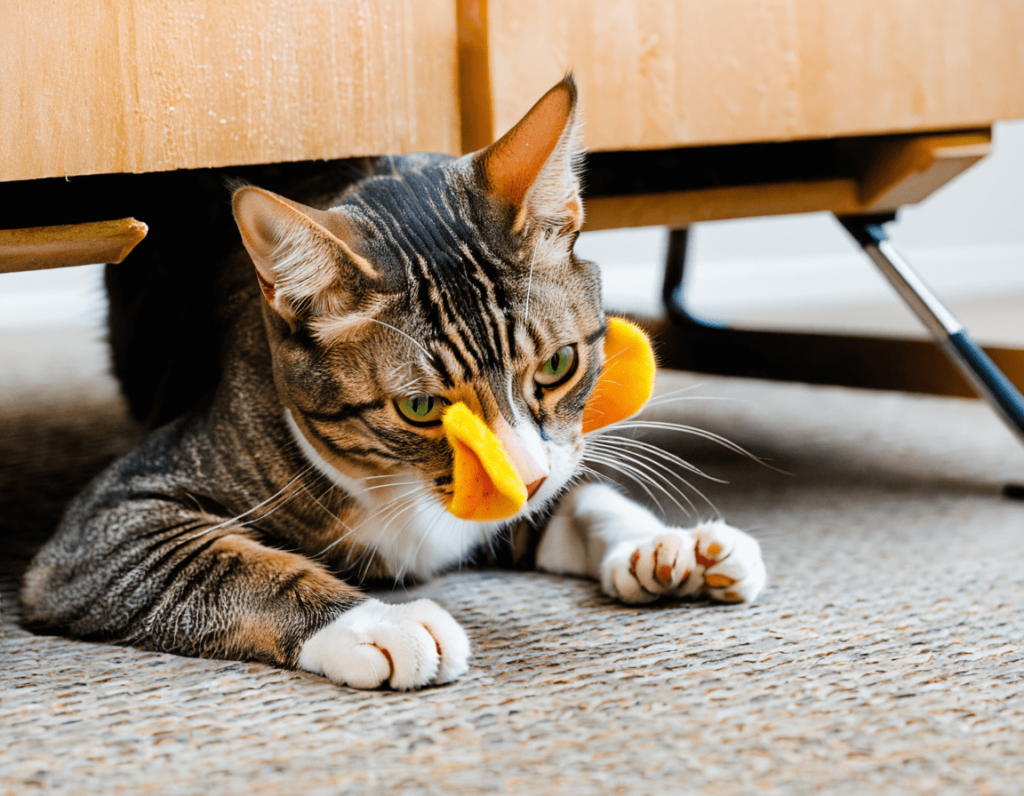
If you’re a cat owner, you’ve likely encountered the occasional shredded couch or frayed curtains, courtesy of your feline friend’s scratching habits. While this behavior may be frustrating, it’s completely natural for cats. In this article, we’ll take a look at why cats scratch, how to stop them from ruining your furniture, and how to redirect this behavior in a way that’s more beneficial to both of you.
So, let’s dive in and learn a bit more about this common (and often hilarious) cat behavior!
Why Do Cats Scratch?
Before you get upset about your cat’s latest masterpiece on your favorite armchair, it’s important to understand why scratching is such an essential part of a cat’s life. Cats scratch for several reasons:
- Marking Territory: Cats have scent glands in their paws. When they scratch, they leave behind a scent that tells other cats, “This is my space.” It’s a cat’s version of putting up a “do not disturb” sign.
- Sharpening Claws: Scratching helps cats shed the outer layer of their claws, keeping them sharp and in top form for climbing, hunting, and, well, looking cool while lounging.
- Stretching and Exercise: Scratching is a full-body workout for cats. It helps them stretch their muscles and keep their bodies agile—so, in a way, they’re just doing some yoga to stay fit!
- Stress Relief: If your cat is stressed or anxious, scratching can be a way for them to release some pent-up energy. It’s their version of a little spa treatment, but with a bit more destruction.
Funny line: You know your cat is serious about their scratching when they give you the “I’m not stopping anytime soon” stare as they tear up your favorite chair.
How to Stop Your Cat from Scratching Furniture
While scratching is a natural behavior, it doesn’t mean you have to let your cat ruin your furniture. Luckily, there are several ways to redirect this behavior and save your beloved couch from becoming a cat’s personal scratching post.
1. Provide Alternatives
The first step in stopping your cat from scratching furniture is to offer them a better option. Invest in a few scratching posts or pads. Place them near your cat’s favorite scratching spots, and be sure to choose one that’s sturdy enough for them to really sink their claws into.
- Vertical Scratching Posts: Cats love scratching things that are tall, so consider a post that’s high enough for them to stretch.
- Horizontal Scratching Pads: Some cats prefer to scratch horizontally, so a flat scratching pad might do the trick.
Most searched keywords related to cat scratching alternatives: “Best scratching posts for cats,” “Cat scratching post vs. pad,” “How to stop cat from scratching furniture.”
2. Use Cat Repellent Spray
If your cat is determined to scratch a particular area, like your couch or carpet, you can try using a cat-safe repellent spray. These sprays have scents that cats dislike, making them less likely to scratch that area. You can find these sprays at most pet stores, or you can make your own using natural ingredients like citrus or eucalyptus oils.
3. Trim Your Cat’s Claws
Keeping your cat’s claws trimmed can reduce the damage they do when they scratch. It won’t stop them from scratching altogether, but it will make their claws less sharp, which means less damage to your furniture.
Funny note: Don’t worry, trimming your cat’s claws won’t turn them into soft, fluffy pillows. They’ll still be able to perform their daily yoga stretches—they’ll just be a little less destructive.
Most searched keywords related to cat claws: “How to trim cat claws,” “Cat claw trimming tips,” “How often should I trim my cat’s claws?”
4. Cover Up the Scratching Area
Sometimes, prevention is the best form of defense. If your cat has a favorite spot that’s getting scratched to death, try covering it up temporarily with aluminum foil, double-sided tape, or a plastic carpet runner with the nubby side up. Cats don’t like the feel of these materials under their paws, so they’re likely to move on to a different area.
5. Reward Positive Behavior
If your cat uses the scratching post instead of your furniture, be sure to reward them with a treat or extra playtime. Positive reinforcement works wonders with cats—if they associate scratching their post with a reward, they’re more likely to do it again.
Kittens are cute and full of energy, but they require lots of time and training. Adult cats, on the other hand, are often calmer and come with established personalities, making it easier to find the right match for your lifestyle. Many adopters find that adult cats are the perfect companions since they are already past the mischievous kitten stage.
What Not to Do
Now that you know how to encourage good scratching habits, it’s important to understand what not to do:
- Don’t Punish Your Cat: Yelling or spraying your cat with water when they scratch can cause fear and anxiety, and it won’t stop the behavior. Cats don’t respond well to punishment—positive reinforcement is much more effective.
- Don’t Declaw Your Cat: Declawing is an inhumane practice and can lead to physical and behavioral issues. Always opt for more ethical ways to manage scratching.

Is scratching a sign of aggression?
It’s important to remember that scratching is not usually an aggressive behavior. Cats are just doing what comes naturally to them. However, if your cat is scratching aggressively or in unusual situations, it could be a sign of stress, anxiety, or a health issue. In those cases, it might be a good idea to consult your vet.
Common Myths About Cat Scratching
Before we finish up, let’s address a few common myths surrounding cat scratching. Because, let’s face it, there’s a lot of misinformation out there, and we’re here to clear the air!
Myth 1: Scratching Means My Cat Is Angry
Not necessarily! While it’s easy to think your cat is frustrated or angry when they scratch the furniture, it’s actually a natural instinct. Cats scratch to mark territory, stretch their muscles, and keep their claws sharp—nothing personal! They’re not out to get you, they’re just doing their thing.
Myth 2: All Cats Scratch the Same Way
Each cat is different. Some love vertical scratching, others prefer horizontal. Some cats even enjoy scratching soft surfaces, while others go for harder ones. Observe your cat’s preferences and try offering a variety of scratching posts or pads to see what they enjoy most.
Myth 3: You Can Stop Scratching Completely
As much as we’d like to see our furniture stay scratch-free, it’s unrealistic to expect your cat to stop scratching altogether. Scratching is a natural, healthy behavior. The goal isn’t to eliminate it, but to redirect it to places where it’s acceptable—like a scratching post or pad.
Funny note: Let’s face it—if your cat could talk, they’d probably say, “I’m a cat, I’m going to scratch. Deal with it.” And honestly, they’d have a point!
When to Seek Professional Help
If scratching becomes excessive or if your cat starts scratching in unusual places (like walls or doors), it may be time to check in with your veterinarian. Sometimes, persistent scratching can be a sign of stress, anxiety, or even medical issues such as arthritis or skin conditions. If you’re worried, it’s always a good idea to get your cat checked out to rule out any underlying health problems.
Final Thoughts: Scratching is Just Part of the Package
In the end, scratching is just one of those quirky cat behaviors that we have to learn to live with (and love). It’s natural, healthy, and even beneficial for your cat’s well-being. By providing the right scratching outlets and managing your cat’s behavior with patience and understanding, you can keep both your cat and your furniture happy.
So, next time your cat takes a swipe at your sofa, just smile and say, “Go ahead, you’ve earned it.” After all, they’re just following their instincts, and with a little effort, you can redirect their scratching to areas where they can express their true inner artist—without leaving your couch in ruins.
Funny line: It’s not your fault your cat scratches your furniture. If you were as flexible as them, you’d probably be scratching your couch too!
Most searched keywords related to cat scratching behavior: “Cat scratching furniture solutions,” “Scratching posts for cats,” “Why do cats scratch,” “How to stop cat from scratching walls.”

FAQs About Cat Scratching
Scratching is one of the most common (and sometimes frustrating) behaviors in cats. While it may seem like your cat has a vendetta against your furniture, scratching is a completely normal, natural activity. To help you better understand your feline friend’s scratching habits, here are some frequently asked questions about cat scratching.
1. Why do cats scratch furniture?
Cats scratch furniture for a variety of reasons. It’s a natural instinct that helps them mark their territory, stretch their muscles, and keep their claws healthy. They also have scent glands in their paws, so scratching leaves behind a scent that marks their space. It’s their way of saying, “This is my territory!”
2. How can I stop my cat from scratching my furniture?
While you can’t stop your cat from scratching altogether (it’s just part of their nature!), you can redirect this behavior by providing alternatives like scratching posts, pads, or even cardboard boxes. You can also use cat-safe repellent sprays on the areas your cat likes to scratch, and reward them when they use the scratching post instead.
3. Can trimming my cat's claws help with scratching?
Yes, trimming your cat’s claws can reduce the damage caused by scratching. While it won’t stop them from scratching, it makes their claws less sharp and damaging to furniture. Be sure to trim them regularly, or take your cat to the vet for a professional trim if you’re unsure how to do it safely.
4. Is scratching a sign of aggression in cats?
No, scratching is generally not a sign of aggression. It’s a natural behavior for marking territory and keeping their claws in good condition. However, if your cat’s scratching becomes overly aggressive or happens in unusual situations, it may indicate stress or anxiety. In that case, it might be helpful to consult with a veterinarian.
5. What’s the best way to train my cat not to scratch the furniture?
Training your cat to stop scratching furniture involves providing a better alternative, such as a scratching post. Place it near the spots your cat likes to scratch, and reward them when they use it. You can also use double-sided tape or aluminum foil on your furniture to deter them, as most cats dislike the texture under their paws.
6. Why does my cat scratch doors and walls?
Some cats may scratch walls, doors, or other odd places because they’re trying to get your attention or because they are bored. It might also be an attempt to mark territory or simply a need to exercise their claws. Providing enough scratching posts or pads and more playtime can help reduce this behavior.
7. How can I make my cat's scratching posts more appealing?
To make scratching posts more appealing, try rubbing them with catnip or spraying them with a cat-attractant spray. You can also vary the type of scratching post (vertical, horizontal, sisal rope, carpet) to see which your cat prefers. Just make sure it’s sturdy enough for them to really dig in!
8. Should I punish my cat for scratching?
No! Punishment doesn’t work well with cats. If you catch them scratching the wrong area, try gently redirecting them to the scratching post instead. Positive reinforcement (like praise or treats) works much better to encourage them to keep using their scratching post.
9. Can cats scratch as a form of stress relief?
Yes, scratching can be a way for cats to relieve stress and anxiety. If there are changes in their environment, such as new people, new pets, or even a move to a new home, they may scratch more often as a way to cope with their feelings. Providing plenty of enrichment, such as toys, playtime, and comfortable resting spots, can help ease their anxiety.
10. Can I stop my cat from scratching completely?
It’s unlikely that you can stop your cat from scratching completely, as it’s an instinctual and essential behavior for them. The goal should be to redirect the scratching to more appropriate places, like scratching posts or pads. With the right training and a little patience, your cat can learn where to scratch and where not to.
11. Is scratching common in all cats?
Yes, all cats scratch—it’s just part of their nature. However, some cats may scratch more than others, depending on their personality, environment, and how well they’ve been trained. Some cats might prefer scratching furniture, while others go for carpets, curtains, or even walls!
Conclusion
Scratching is a normal and healthy part of cat behavior. Understanding why cats scratch and how to manage it will help you protect your furniture and provide your cat with an outlet for their natural instincts. With patience, the right tools, and a bit of creativity, you can teach your cat where to scratch and keep both your cat and your home happy!


